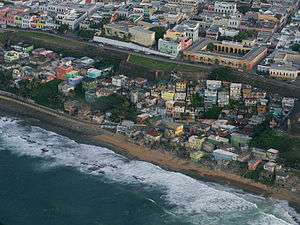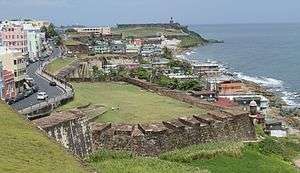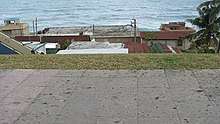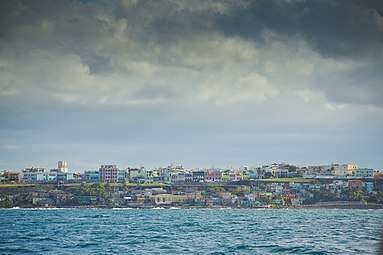La Perla, San Juan, Puerto Rico
La Perla is a historical shanty town astride the northern historic city wall of Old San Juan, Puerto Rico, stretching about 650 yards (600 m) along the rocky Atlantic coast immediately east of the Santa Maria Magdalena de Pazzis Cemetery and down the slope from (north of) Calle Norzagaray.


La Perla was established in the late 19th century. Initially, the area was the site of a slaughterhouse because the law required them and homes of former slaves and homeless non-white servants – as well as cemeteries – to be established away from the main community center; in this case, outside the city walls. Sometime after, some of the farmers and workers started living around the slaughterhouse and shortly established their houses there.
Only three access points exist, one through the "Santa Maria Magdalena Cemetery", one on the east side and one through a walkway right in the center of the northern wall.
Utility services
Despite many of the homes being built without proper permits, residents of the neighborhood do have utility services. Garbage pickup is done regularly in La Perla neighborhood, which in 1973 consisted of about 900 houses and 3,300 residents.[1]
Streets

The streets of La Perla are not indicated on most city maps in order to deter tourists from walking into the high crime area:
- Calle Tiburcio Reyes (western border, along the outside of the old city wall)
- Calle San Miguel (mostly in the western part, along the north)
- Calle Bajada Matadero (mostly in the western part, along the south)
- Calle Lucila Silva (mostly in the western part, east-west through the middle, too narrow for cars)
- Calle Augustin O Aponte (eastern part)
La Perla was the true site of the fictional "La Esmeralda" barrio depicted in Oscar Lewis's sociological work, "La vida: a Puerto Rican family in the culture of poverty--San Juan and New York", describing the lives of Puerto Rican slumdwellers and prostitutes from La Perla, through taped interviews with dozens of intertwined family members who lived there in the 1940s-1960s. His award-winning book, written in 1967, would influence the way people viewed Puerto Rican women. "Many who read his book assumed the whores of La Perla were typical of all Puerto Rican women."[2]
In 2016, students of architecture at several universities in Puerto Rico, requested children's ideas on an initiative to improve areas of La Perla where children enjoy meeting up with friends.[3][4][3][5]
Census
In terms of the United States 2000 Census, La Perla is composed of Census blocks 3001 through 3010 (Block group 3, Census tract 4, San Juan, Puerto Rico). A population of 338 was reported, 198 housing units (29 unoccupied), and 169 households, on an area of 80,028 square yards (16.53 acres; 66,914 m²).
La Perla belongs to and consists of the northernmost stretches of the subbarrios Mercado (west) and San Cristóbal (east) of Old San Juan. The dividing line between the subbarrios is the imagined extension of Calle San Justo to the north beyond the old city wall to the Atlantic coast. The eastern part consists of Census blocks 3002, 3009 und 3010, with a population of 64, 35 housing units (4 unoccupied), and 31 households, on 41,348 square yards (8.5 acres; 34,572 m²).
Media

La Perla has a community oriented music recording studio, El Estudio D' Oro, which serves as a free of cost music production workshop for all ages. El Estudio D' Oro is also home to the FM urban radio show, Hip Hop 787 La Verdadera Escuela, which is broadcast live from the studio on WVOZ Mix 107.7 FM.
In 1978, salsa singer Ismael Rivera had a hit song, written by composer Catalino Curet Alonso, in honor of this community, and named after it. In 2009 Urban Music group Calle 13 released another tribute song, also named La Perla, in collaboration with Ruben Blades. In the song, Blades references Rivera's early effort; in the song's video, Blades pays his respects to Curet by visiting his tomb at the community's Santa María Madgalena de Pazzis cemetery.
Canadian singer Nelly Furtado along with Calle 13 band member Residente filmed the music video to the remix of Furtado's song No Hay Igual on 26 June 2006 in La Perla. Residente said he hoped that the video would help them both reach new audiences: "It's a good opportunity for us both. More than the North American market, the European market really interests me and her because her family is Portuguese."[6] The video was directed by Israel Lugo and Gabriel Coss, photographed by Sonnel Velazquez and produced by María Estades.[7]
The motion picture The Vessel (film) starring Martin Sheen about a tidal wave that destroys a small town was filmed in La Perla in 2013.
With more than 6 billion views on YouTube, La Perla became world-known with the music video for the song Despacito being filmed there.[8]
Hurricane damage and response
La Perla and the song "Despacito" (translation: "slowly") have been highlighted in news about the slow response to the destruction from Hurricanes Irma and Maria on the area where the video was filmed.[9]
Gallery
 La Perla neighborhood in San Juan
La Perla neighborhood in San Juan La Perla coastline in 2018
La Perla coastline in 2018 La Perla view from the sea in 2012
La Perla view from the sea in 2012
See also
References
- Cordasco, F.; Bucchioni, E. (1973). The Puerto Rican Experience: A Sociological Sourcebook. Littlefield, Adams quality paperback. Rowman and Littlefield. p. 109. ISBN 978-0-87471-162-2. Retrieved 31 August 2019.
- Steiner, S. (1974). The Islands: the worlds of the Puerto Ricans. Harper Colophon books. Harper & Row. p. 362. ISBN 978-0-06-014079-3. Retrieved 31 August 2019.
- "La participación en el diseño de espacios que habitamos".
- https://quod.lib.umich.edu/d/dialectic/14932326.0002.107/--landscape-of-community-and-participatory-design-in-puerto?rgn=main;view=fulltext
- Derr, Victoria; Chawla, Louise; Mintzer, Mara (September 18, 2018). "Placemaking with Children and Youth: Participatory Practices for Planning Sustainable Communities". New Village Press – via Google Books.
- "Furtado films video in Puerto Rico". Jam!. Canoe.ca. Archived from the original on June 29, 2006. Retrieved 10 March 2013.
- "Nelly Furtado graba video en La Perla en el Viejo San Juan junto con Residente de Calle 13" Archived 2011-10-04 at the Wayback Machine (Spanish). ¡Boom! Online. 26 June 2006. Retrieved 14 November 2006.
- Contreras, Felix (December 13, 2017). "The 100 Best Songs Of 2017". NPR. p. 3. Retrieved December 5, 2018.
- "Post-Hurricane Help Slow To Arrive In 'Despacito' Neighborhood". NPR.org. Retrieved 2017-10-02.
Bibliography
- Florian Urban (2015). "La Perla: 100 years of informal architecture in San Juan, Puerto Rico". Planning Perspectives. 30. doi:10.1080/02665433.2014.1003247.